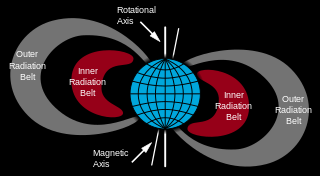Van Allen radiation belt
A Van Allen radiation belt is a zone of charged particles which come from the Sun as the solar wind. They are captured and held by the Earth's magnetic field.

Earth has two such belts and sometimes others. The belts were discovered by James Van Allen. Earth's two main belts extend from the altitude of about 500 to 58,000 km (310 to 36,040 mi)[1]
Most of the particles that form the belts are thought to come from solar wind and other particles by cosmic rays.[2] By trapping the solar wind, the magnetic field deflects those energetic particles and protects the atmosphere from destruction.
The belts are in the inner region of Earth's magnetosphere. The belts trap energetic electrons and protons. The belts endanger satellites, which must have their sensitive components protected with adequate shielding if they spend much time in that zone. In 2013, NASA reported that the Van Allen Probes had discovered a third radiation belt, which was observed for four weeks. It was destroyed by a powerful, interplanetary shock wave from the Sun.[3]
References
change- ↑ Zell, Holly (February 12, 2015). "Van Allen Probes Spot an Impenetrable Barrier in Space". NASA/Goddard Space Flight Center. Archived from the original on 2020-03-06. Retrieved 2017-06-04.
- ↑ "Van Allen Radiation Belts". HowStuffWorks. Silver Spring, MD: Discovery Communications Inc. Retrieved 2011-06-05.
- ↑ Phillips, Tony, ed. (February 28, 2013). "Van Allen Probes Discover a New Radiation Belt". Science@NASA. NASA. Archived from the original on 2019-12-07. Retrieved 2013-04-05.